|
Dedication
This dissertation is dedicated to my late father who passed
away by the time I had started it (on 30th May 2011),
To my mother,
To my six young brothers and two young sisters,
And to all who, in one way or the other, contributed to my
education
Acknowledgements
Above all I thank the Almighty God that started the work in me
and has been my shepherd throughout my life in general, but particularly in my
bachelor's degree course and in this research work.
First and foremost I thank the government of Rwanda through
students financing agency of Rwanda (SFAR) for granting me the scholarship
which helped me to complete my bachelor's degree and this research in
particular.
In a special way, I conceive and extend my sincere gratitude
to my supervisor and mentor at the same time Mr. Jean Pierre BIZIMANA, for all
the academic inputs that shaped this work and ultimately shaped myself. Your
proper and timely guidance given to me not only when I sought help, but also
whenever it deemed necessary to you, is an unforgettable mood in my life!
My growth in academia has been a result of combined efforts
from different individuals especially all lecturers in the department of
geography. Special thanks go to the former heads of department of geography
Prof. Emmanuel TWARABAMENYE and Dr. Theophile NIYONZIMA; the current head of
department Mr. Alban SINGIRANKABO, all geography department staff especially
Dr. Gaspard RWANYIZIRI, Mr. Charles GAKINAHE, Mrs. Marie Christine SIMBIZI, Mr.
S. MUSANGWA and all visiting members of staff.
I also acknowledge both local leaders and residents of Kigali
city who sacrificed their time to answering my questions and attending my
interviews.
Without contributions of my classmates, I wouldn't have been
able to make certain achievements. I thank all my classmates especially Mr.
MUNYESHYAKA Jean Pierre who in most assignments made great contributions hence
benefiting the whole group.
I cannot forget the happiest moments I shared with Mr.
GABINEMA Celse, Mr. BYIRINGIRO Fabrice and Mr. MUNYESHYAKA Jean Pierre whom we
stayed together in one room in my final year.
1 Abstract
Resettlement planning is a new kind of planning in Rwanda that
was introduced after the approval of the Kigali city conceptual master plan in
2007 as a means of renewing the city and ensuring proper planning. The master
plan proposes the extension of the central business district (CBD) in Muhima
sector which is occupied by informal settlements on the prime land suitable for
vibrant business. As the first phase in implementing the master plan of the
CBD, a zone of Ubumwe cell was cleared and residents were resettled in Batsinda
housing estate. This attracted the author to do research on the challenges in
the transition from unplanned settlement to new housing development in Kigali
city by considering Amahoro cell that is targeted in the second phase of
implementation of the CBD.
The data was collected using semi-structured and structured
questionnaires for Amahoro cell residents and leaders at different levels in
Kigali city, to know their perception on the resettlement process in Kigali
city through expropriation and the challenges involved therein.
The study was exploratory in nature and combined both
descriptive statistics and explanatory methods to analyze quantitative and
qualitative data which was collected from the field respectively. Microsoft
excel was used to analyze quantitative primary data, and this appears in
tabular output frequency tables, and charts were used to analyze the
relationships between the variables.
The results show that the main challenges in the transition
from unplanned settlement to new housing development are low expropriation
prices, reluctance of investors to acquire expropriated land for development,
dissatisfaction of constructed houses by Kigali city, large informal
settlements and low awareness of the residents about the benefits of
expropriation in public interest.
Key words:unplanned settlement,
expropriation, relocation, new housing development
Table of contents
Dedication
Erreur ! Signet non
défini.
Acknowledgements
ii
Abstract
iii
Table of contents
iv
List of tables
vi
List of figures
vii
List of photographs
viii
List of acronyms and abbreviations
ix
1 GENERAL INTRODUCTION
1
1.1 Background to the study
1
1.2 Definitions of the working concepts
3
1.3 Problem statement
4
1.4 Research interest and motivation
7
1.5 Research hypotheses
8
1.6 Research objectives
8
1.7 Research design
10
1.8 Scope of the study
11
1.9 Problems and limitations
11
1.10 Organization of the research
11
2 RESEARCH METHODOLOGY
12
2.1 Study area
12
2.2 Data collection methods
14
2.2.1 Secondary data collection
.............................................................................................................
14
2.2.1.1 National documents and policies
15
2.2.1.2 Spatial datasets acquisition
15
2.2.1.3 Academic documents
15
2.2.2 Primary data collection
.............................................................................................................
15
2.2.2.1 Field observation and field
measurement
15
2.2.2.2 Field survey
15
2.2.3 Sampling techniques and sample
size..................................................................
16
2.3 Data integration, processing and
analysis
18
3 RESULTS AND DISCUSSIONS
19
3.1 Relocation experience in Ubumwe cell
19
3.2 Existing situation of Amahoro cell
22
3.2.1 Nature of
housing.................................................................................
..........
22
3.2.2 Physical and social
infrastructure...............................................................
..........
25
3.3 Planning implications of Amahoro
cell
28
3.4 Resident's perception on informal
housing upgrading and master plan implementation
29
3.4.1 Perception on Kigali master
plan...............................................................
..........
30
3.4.2 Perception on expropriation process
and relocation.......................................... ..........
31
3.5 Housing regulation in Kigali city
34
3.6 Impact of new housing policies on
unplanned settlement dwellers
36
3.6.1 Positive
impacts...................................................................................
.........
36
3.6.2 Negative
impacts...............................................................
......................................
37
3.7 Housing demand in Kigali city
38
3.8 Strategies for housing low and medium
income groups in Kigali city
38
3.9 Major housing developers in Kigali
city
40
3.10 Challenges in new housing development
in Kigali city
43
4 CONCLUSION AND RECOMMENDATIONS
45
4.1 Conclusion
45
4.2 Recommendations
46
Reference
48
Annex 1: Questionnaire for residents
xi
Annex 2: Questionnaire for local leaders
xvi
ANNEX 3 Compensation prices
xxi
List of tables
Table 1: Number of households in Amahoro
cell
3
Table 2: Surveyed households in each
Umudugudu
17
Table 3: Interviewed local leaders in Kigali
city
18
Table 4: Periods of plot acquisition in
surveyed households
23
Table 5: Residents' judgment on the
sustainability of building materials in their neighborhood
30
Table 6: Residents' perception on
implementation of KCMP
32
List of figures
Figure 1: Map of Muhima sector
3
Figure 2: Location of Amahoro cell in Muhima
sector
14
Figure 3: Image of Ubumwe site before
clearance
20
Figure 4: Type of building materials of walls
of houses
24
Figure 5: Orthophoto showing roads crossing
Amahoro cell
26
Figure 6: Residents' preferences if susceptible
to relocation
33
Figure 7: Residents' perception on
expropriation prices in Kigali city
34
Figure 8: Housing prototype for Kinyinya
residential township
40
List of photographs
Photograph 1: Current situation of the cleared
site of Ubumwe
3
Photograph 2: Stones supporting old iron
sheets
24
Photograph 3: A house gradually falling
down
25
Photograph 4: Source of water in Amahoro
cell
27
Photograph 5: State of the drainage
system
28
Photograph 6: House under roof
painting
29
Photograph 7: Gacuriro houses built by
RSSB
41
Photograph 8: Batsinda model house
42
List of acronyms and
abbreviations
CBD: Central business district
ECA: Economic Commission for Africa
EDPRS: Economic development and poverty reduction strategy
KCC: Kigali city council
KCMP: Kigali conceptual master plan
MINECOFIN: Ministry of economic planning and finance
MININFRA: Ministry of infrastructure
NGOs: Nongovernmental organizations
RHA: Rwanda Housing Authority
RHB: Rwanda Housing Bank
RSSB: Rwanda Social Security Board
2 GENERAL INTRODUCTION
2.1 Background to the
study
It's easy to understand the fundamental need for shelter.
People require protection from weather elements, somewhere to bring up their
families, a place to work from and a home to call their own. Yet, at present,
over one billion people - a fifth of the world's population - are either
homeless or live in very poor housing (Mutekede, 2007). The majority of them
are the poorest people of the world's developing countries. Poor families in
developing countries are forced to improvise with their housing, either because
building materials are too costly or - in areas vulnerable to natural hazards
such as floods and landslides- good building land is too expensive.
With affordable, suitable land becoming scarcer, especially in
urban areas, poor people find it increasingly difficult to find the resources
to build houses of their own or to buy or rent houses built by professionals.
Instead, they build houses with poor and unsustainable materials on a small
piece of land which cannot support any other domestic activities. When such
kind of houses concentrates on a given urban area, especially without land
rights, they result into informal settlement or slum. This type of settlement
is characterized by inadequate infrastructure, unsustainable environments,
uncontrolled and unhealthy population densities, poor access to health and
education facilities and employment opportunities, lack of effective governance
and management and inadequate dwellings (Durand-Lasserve, 2007).
According to UN estimates, 924 million people - nearly one out
of three urban dwellers - were living in slums in 2004. Of these, 874 million
are from low and middle-income countries (millennium project, 2005). In
addition, urban poverty is clearly increasing: 43% of the population of
developing cities is living in slums (28% in north Africa, 71% in sub-Saharan
Africa, 42% in Asia and 32% in Latin America) ( UN-Habitat, 2003). By 2020,
this figure is expected to increase to 1.5 to 1.7 billion, depending on
estimates. According to Cohen (2004), estimates suggest that 2.8 billion will
need housing and urban services in 2030. The slum population is expected to
increase from 32% of the world population in 2001, to 41% in 2030.
So far, no satisfactory solution for addressing the challenge
of slums has been found. Conventional responses are usually based on the
combination of three main types of settlement: (i) in situ upgrading in
existing informal settlements; (ii) evictions followed by resettlement on
serviced sites on the periphery of cities; (iii) the preventive provision of
low-cost serviced plots for housing (UN-Habitat, 2003). These responses have
achieved limited results. Despite some major successes where political will and
continuity, economic development and mobilization of resources in sufficient
quantities have made possible the implementation at the national level of
innovative policies for housing the poor (South Africa, Brazil, Tunisia etc),
scaling up remains a major problem. Most slum policies are simply treating the
symptoms and cannot be considered as structural and sustainable policies.
In the United Nations millennium declaration (UN-Habitat,
2003), world leaders pledged to tackle this immense challenge, setting the
specific goal of achieving significant improvement in the lives of at least 100
million slum dwellers by the year 2020. This goal may be achievable through
governments putting in place special urban policies that address the plight of
slum dwellers and the poor.
Rwanda is one of the most densely populated countries in
Africa, and its capital Kigali is growing at a rate of about 6% per annum
(MINECOFIN, 2006). Until recently, there was no national law or policy relevant
to construction, housing, or urbanization, apart from a national program to
cluster rural housing in Imidugudu. This led to a spontaneous
development of informal housing in most parts of the city.However, as a roadmap
to achieve Rwanda's 2020 vision, together with other planning documents ,
Kigali conceptual master plan was established in 2007 (MININFRA, 2007).
According to KCMP existing situation analysis, existing city development
portrays a largely unplanned mixed use settlement, except in industrial areas
where these uses are likely to be more concentrated in random parts of the city
outskirts. Redevelopment and upgrading in the existing urban area must be
addressed as a special case within the overall urban development because of a
number of complexities.
2.2 Definitions of the
working concepts
Unplanned settlement:unplanned settlements are areas
where housing is not in compliance with current planning and building
regulations (unauthorized housing).
Housing:act of providing shelter or lodging.
Slum:usually a heavily populated area, characterized
by poverty, poor housing, etc. (investors.com)
Slum clearance:the removal of old decrepit buildings
to allow the land to be put to a better and more productive use; also
frequently referred to as urban renewal (investors.com).
Slum upgrading:the consistence of physical, social,
economic, organizational and environmental improvements to slums undertaken
cooperatively and locally among citizens, community groups, businesses and
local authorities (Wikipedia).
Public interest: welfare of the general public in
which the whole society has a stake and which warrants recognition, promotion
and protection by the government and its agencies (legal-dictionary). According
to the law No. 18/2007 of 19/04/2007 relating to expropriation in public
interest in Rwanda, an act of public interest is an act of government, public
institution, nongovernmental organization, legally accepted associations
operating in the country or of an individual, with an aim of public
interest.
Expropriation:according to business dictionary,
expropriation is a compulsory seizure or surrender of private party for the
state's purposes, with little or no compensation to the property's owner.
Governments or their agencies can affect an expropriation by making changes in
legal code, tax code or regulations such as zoning. According to the law No.
18/2007 of 19/04/2007 relating to expropriation in public interest in Rwanda,
expropriation is defined as the taking of private property in public interest
aimed at development, social welfare, security and the territorial
integrity.
Relocation:the establishment in a new residence or
place of business.
Informal settlement:areas where groups of housing
units have been constructed on land that the occupants have no legal claim to,
or occupy illegally.
Master plan:according to answers.com, a master plan
isa comprehensive document that describes, in narrative and with maps, an
overall development concept of a city or planned-use development.
2.3 Problem
statement
The world is faced with the reality that many large- and
medium-sized cities are increasingly becoming areas of impoverished urban
exclusion, surrounding comparatively small pockets of urban wealth (UN-Habitat,
2003). Frequently, this trend is the spatial outcome of mismatches and
disconnections between national macro-policies and the absence of coherent
connections with the policies at the city level. Worldwide, cities are
predominantly and preferred residential locus of the majority of the
population. However, a big number of this urban population live in informal
settlements due to poverty since most of them are rural-urban migrants with low
or no income. This has increased the need for adequate housing in urban areas
(MININFRA, 2008).
Most cities in sub-Saharan Africa and some in northern Africa
and western Asia showed considerable housing stress, with rents and prices
rising substantially while incomes fell, probably corresponding to higher
occupancy rates (UN-Habitat, 2003). In addition, slum areas increased in most
cities, and the rate of slum improvement was very slow or negligible in most
places. Most governments have established policies to camp down the problem of
slums/informal settlements but these policies seemed to treat symptoms rather
than eradicating the problem.
In South Africa, a very large housing program reduced the
numbers in informal settlements significantly. However, the housing
formalization that occurred in South Africa reinforced the marginalization and
stigmatization of the poor (Bond and Tait, 1997:28). The process of housing in
South Africa is taking place within a context of widespread poverty (Smit,
2000). Smit's report revealed that unemployment rate was 34% and an estimated
39% of the population had less than minimum nutritional intake of 2000 Kcal per
day according to the 1996 census. This implies that providing necessary
infrastructures alone by the government cannot uproot informal settlements.
In 2008, the government of Rwanda adopted the national urban
policy that aims at guiding government objectives and priorities in line with
the objectives as laid down particularly in the vision 2020, the EDPRS and the
national investment strategy (MININFRA, 2008). According to the aims of vision
2020, about 30% of the population will live in cities with access to basic
infrastructure necessary to ensure sustainable development. However, there is a
big challenge of addressing the existing informal settlements that comprise a
larger part of Rwandan urban areas.
Slums and poor settlements characterize Kigali, the capital
city of Rwanda, like any other city in third world countries. The current
statistics by Kigali city council (KCC) show that the unplanned settlements
comprise a massive more than 70 percent (Martin, 2007). Some individuals in
Kigali City were formerly allocated plots and they built without plan
irrespective of the laws governing the built environment of the country. This
resulted into slums and poor structures that hinder infrastructure development
and the government's ability to provide other services in such areas.
During the postcolonial era, soon after independence, the
republic of Rwanda decided to make Kigali the capital city of Rwanda. This
designation as capital of Rwanda and relocation of all national ministry
functions fueled growth of Kigali beyond the Nyarugenge hill to five
neighboring hills: Nyamirambo, Gikondo, Kimihurura, and Kacyiru. From 1962 to
1984, the population and the built area of Kigali expanded rapidly. The
population grew at around 16% from around 6,000 people to over 150,000. The
built area expanded over 12 square kilometers. Kigali continued to expand until
1994 without prior urban planning.
After 1994 genocide, a massive population from exile in
neighboring countries, and immigrants from rural areas in fear of insecurity,
settled in Kigali city by acquiring land illegally and constructing informal
houses. The rural-urban exodus to Kigali city continued, and currently the
population of Kigali city is about one million. Informal settlement/slum
quarters developed and grew in areas such as Muhima in a place commonly known
as «Kiyovu cy'abakene», Kimihurura, Kimicanga, Gikondo and
Nyamirambo. These slum areas shelter the majority of urban poor who have no
regular income and they characterized by high fertility rates. The high density
of the houses in informal settlements results in poor sanitation, lack of
infrastructure such as roads, water supply and other basic public utilities.
In order to direct urban development for the next 30-50 years,
Kigali conceptual master plan (KCMP) was established in 2007 after two years of
study. The implementation of KCMP is hindering the majority of Kigali city
urban dwellers in informal settlements (most of whom low-income earners) from
making small redevelopments on their houses or extending them because they do
not conform to the required construction standards or minimum plot size. In
addition, these people may be settling in an area that is planned for other
land use rather than residential according to the master plan and may be
susceptible to relocation. In line with the implementation of KCMP, Kigali
master plan implementation projects have been developed starting with immediate
developmental zones.
Among these projects is the central business district (CBD)
development project that will be implemented in phases. In phase 1, central
business district 1(CBD1) will be developed and will cover a total project area
of 150Ha of Muhima sector. In phase 2, central business district 2 (CBD2) will
be developed and will focus on the upgrading of the existing CBD. This will be
an ongoing scheme that will involve the active participation of the existing
business community of this area.
As part of the implementation phase of CBD1, a quarter known
as `Kiyovu cy'abakene' in Ubumwe cell was cleared. According to
detailed master plan for CBD1 (Anandan and Hrydhal, 2010), the cleared site was
selected for the development of phase 1 of the CBD- the city's first experience
in developing large-scale commercial development. This site has been marked for
high-end commercial and mix use developments, supported by high-quality public
spaces and facilities. A central green space flanked by high-rise and office
blocks mark the core of the development. In order to develop the CBD,
privately-owned land need to be acquired. This means that compensating them through expropriation must relocate
residents in the selected site. Some expropriated residents in `Kiyovu
cy'abakene' were helped to acquire new houses in Batsinda while others
were not satisfied with the standard of the constructed houses and the
available infrastructures in Batsinda and were given their compensations and
went to find their chosen standard of houses. Most of the expropriated
residents say that compensations are low compared to the cost of land after
clearance of their houses. They complain that they were paid cheaply and that
Kigali city wanted to make enormous profits from Ubumwe cell (Ester, 2009). The
cost of land in Ubumwe cell after expropriation is several times higher than
the expropriation cost. This seems to be the reason why investors are reluctant
to acquire land in this site for the construction of proposed buildings.
Amahoro cell is another site in Muhima that will be developed
for a new CBD (CBD1). Currently, a relatively large part of Amahoro cell is
predominantly settled by residents in semi-permanent, high-density houses,
scattered and found in and around the wetland. This situation implies that the
government, Kigali city or investors must acquire land from private owners for
the development of the CBD, construction of necessary infrastructure or
conservation of the wetland and green spaces.
The problem is however, how the low-income earners in
informal/slum settlements of these areas will cope with this new development.
Will they be expropriated and released to find new settlements in other areas?
Will the city council in collaboration with its donors,
private sector, NGOs or other government agencies provide decent housing to
these people?Or they will be evicted on government power domain since most of
them have no land tenure documents or building permits? What is the perception
of Amahoro cell residents on expropriation for new housing development?
This research sought to answer these questions and analyzed
the impacts these solutions will incur if implemented, considering Amahoro cell
in Muhima sector, Nyarugenge district as case study.
2.4 Research interest
and motivation
As UN-Habitat stipulates, 46% of the African population lived
in slums/informal settlements where poverty, overcrowding, unemployment, crime
and pollution are prevalent (ECA and UN-Habitat, 2008). This is a big challenge
not only to the governments and their partners, but also for researchers to
offer their contribution in revealing areas that need immediate intervention
and recommending sustainable remedies to respond to ever-increasing housing
needs.
With reference to Kigali city, the city council in
collaboration with the government has established policies and laws to
streamline urban housing and informal settlement upgrading. These include urban
housing policy, land tenure reform policy, land law and Kigali master plan. The
implementation of these policies, laws and other regulations in place faces a
lot of challenges due to a significant number of informal quarters in Kigali
city. This has attracted attention of the researcher and encouraged him to
carry out a study in one of the informal settlement quarters in Kigali city to
assess the impact of the transition from informal housing to formalized
housing.
In addition, this research was conducted in partial
fulfillment of the requirements for a bachelor's degree of science in geography
at the national university of Rwanda.
2.5 Research
hypotheses
1. There are challenges in implementing rules and regulations
related to housing especially at grass root level in Kigali city.
2. Residents in informal settlement are inappropriately
expropriated which results in creation of new informal settlements in the
neighborhoods/peripheries of Kigali city.
2.6 Research
objectives
General objective
The overall objective of this research was to assess the
challenges in the transition from unplanned settlements to new housing
development in Kigali city.
Specific objectives and research questions
|
Specific objectives
|
Research questions
|
|
Highlight the existing situation and new trends of housing in
Kigali.
|
1. How is informal housing defined in Kigali city?
2. How is the housing status in Amahoro cell in Muhima sector?
3. What is planned for Amahoro cell according to Kigali
conceptual master plan?
4. What does the government plan for the poor residents in
informal houses in Amahoro cell?
|
|
Analyze residents' perception on new housing development
strategies in Kigali city.
|
1. How do people in informal houses perceive housing development
in Kigali city?
2. How do people in informal houses conform to the new building
requirements in Kigali city especially in their cell?
|
|
Discuss policies, rules and regulation standards that control
housing in Kigali city.
|
1. What are the policies, rules and regulations that control
housing in Kigali city?
2. What are the strategies used to implement housing policies,
rules and regulations in Kigali city?
|
|
Analyze the impact of implementing new housing development
policies on unplanned settlement dwellers in Kigali city.
|
1. What are the positive and negative impacts that result from
the implementation of new housing development policies on unplanned settlement
dwellers in Amahoro cell?
2. What does the leadership of Kigali city do or plan to do in
order to overcome the negative impacts?
3. What are the recommendations towards better and socially
inclusive housing in Kigali city?
|
2.7 Research
design
GENERAL INTRODUCTION
Problem statement &
Motivation
Research objectives
Scope of the study &
Organization of the study
Overall objectives
Specific objectives & research questions
RESEARCH METHODOLOGY
Study area description
Data collection techniques
Data processing
Limitations of the study
Primary data collection
Secondary data collection
Field observation, questionnaire survey, structured interview
Library research
Official documents
RESULTS AND DISCUSSION
Housing situation in Amahoro cell
Planning policies, housing norms and standards
Challenges in housing development
CONCLUSION AND RECOMMENDATIONS
REFERENCES & APPENDICES
Chapter1
Chapter 2
Chapter 3
Chapter 4
2.8 Scope of the
study
This research focuses on the housing conditions in Amahoro
cell of Muhima sector, Nyarugenge district in Kigali city. It also reveals
planning implications in Amahoro cell and how they affect informal urban
dwellers. The research concludes by suggesting some recommendations towards
decent and socially inclusive housing development in Kigali city.
2.9 Problems and
limitations
Apart from constraints of time and resources, reluctance and
irregular availability of local leaders to meet agreed appointments for
interviews, no other major limitations that were faced in conducting this
research. Therefore the research bears the output of the set objectives.
2.10 Organization of the research
This study is organized into four chapters, each with sections
and subsections. Chapter one introduces the study by giving background
information on the study, problem statement, definitions of the working
concepts, research motivation, objectives of the study, scope of the study and
the research design; chapter two is about research methodology and description
of the study area; chapter three presents the results and their
interpretations; while chapter four states major conclusions and
recommendations.
3 RESEARCH METHODOLOGY
3.1 Study area
Kigali, the capital city of Rwanda is subdivided into 3
districts; Gasabo, Kicukiro and Nyarugenge. Amahoro cell which is the case
study is found in Muhima sector, one of the 10 sectors comprising Nyarugenge
District i.e. Gitega, Kinyinya, Kigali, Kimisagara, Mageragere, Muhima,
Nyakabanda, Nyamirambo, Nyarugenge, and Rwezamenyo. Muhima sector is populated
by 31, 866 people spread over 7 cells (Tetero, Kabeza, Kabasengerezi, Amahoro,
Nyabugogo, Ubumwe, Rugenge) with a total area of 292 hectares. It is
characterized by a habitat under-equipped and spontaneous. It is the subject of
urban restructuring that is part of a pilot project of the new blueprint for
the city of Kigali, which aims to make this site a hub of business.
Figure 1: Map of Muhima sector
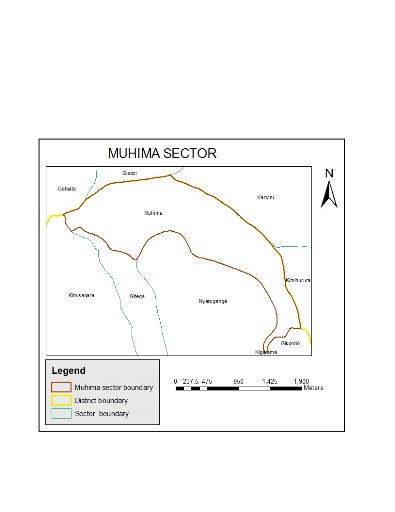
Source: Administrative boundaries
of Rwanda; modified by author
Amahoro cell is further subdivided into six villages/
Imidugudu (see table 1):
Table 1: Number of households in Amahoro
cell
|
Sector
|
Villages/Imidugudu
|
Number of households
|
Population
|
Total population
|
|
Muhima
|
Amahoro
|
130
|
843
|
5,083
|
|
Amizero
|
415
|
914
|
|
Inyarurembo
|
126
|
555
|
|
Kabirizi
|
256
|
847
|
|
Ubuzima
|
395
|
989
|
|
Uruhimbi
|
254
|
935
|
Source: Executive
secretary/Amahoro cell
Amahoro cell is located at the northern part of Muhima sector
as the following map shows:
Figure 2: Location of Amahoro cell in Muhima
sector
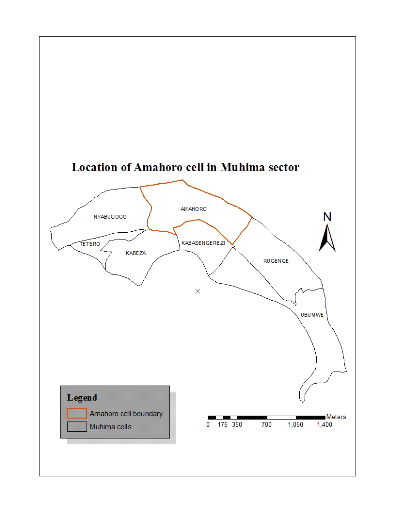
Source: Rwanda Natural Resources
Authority
3.2 Data collection
methods
Data collection techniques refer to a set of methods and
principles that are used when conducting a study on a particular subject or
doing a particular kind of research work. This part shades light on the
different methods in which data needed for the research was obtained. These
techniques included:
3.2.1 Secondary data collection
Secondary data used in this research was obtained from
different publications from library and electronic sources. The publications
are categorized as follows:
3.2.1.1 National
documents and policies
In order to link the primary information and the researcher's
ideas with the government programs, different policies and laws were reviewed.
3.2.1.2 Spatial
datasets acquisition
Shape files of Rwanda administrative boundaries were extracted
from the geodatabase of Rwanda natural resources authority in order to localize
the study area on a map.
3.2.1.3 Academic documents
Dissertations and theses were consulted to find out how much
work already done on the topic in different parts of Rwanda or other parts of
the world by other academicians.
3.2.2 Primary data collection
This technique was employed to gather data directly from the
targeted population in the study area and concerned government authorities. The
following instruments were used to collect the necessary primary data from the
study area, residents in the study area and government officials.
3.2.2.1 Field observation and field measurement
This method will be used to explore the current situation of
the study area in terms of the nature of housing. This technique is a
systematic approach that involves accurate watching and noting of the situation
as it occurs in the natural order. With this technique, some photographs were
taken to well represent the situation on the field.
3.2.2.2 Field survey
To obtain necessary data through field survey, two techniques
were used; questionnaire and interview.
3.2.2.2.1 Questionnaire survey
In order to obtain further primary data through field survey,
a structured questionnaire was used.The questionnaires were designed and
administered through self-completion of the responses directly from the
respondents. Two kinds of questionnaire were designed- one designed for each
selected household in the study area, and another one for the local leaders.
3.2.2.2.2 Interview
In this method, direct questions were administered between the
researcher and respondents in which a positive approach was used to obtain the
required information. Relevant questions to those designed in the questionnaire
were asked in the same sequence to ensure consistency, efficiency, and
accuracy.
The targeted interviewees were the personnel in charge of
urban planning in Nyarugenge district, the one in charge of infrastructure in
Muhima sector and the executive secretary of Amahoro cell. And one personnel in
charge of urban planning in Rwanda housing authority was interviewed.
3.2.3 Sampling techniques and sample
size
Simple random sampling was employed in order to secure
necessary data from the study area, which gave a chance to every individual
household in the study area. To determine the sample size, the following
formula was used (Javeau, 1985):
n= Nxno
N+no
Where n is the sample size,
N is the population size within the study area.
no is the constant
N: B In the study area, the target population was represented
by households and the total number of households in Amahoro cell was 1576, no
(the constant) is calculated from two complementary events p and q. where
p=q=0.5 p+q=1
In his theory, Cochran (1963:75) developed the equation which
gives the value of no as follows:
no= z2xpxq
e2
Where z is the threshold of confidence which is estimated to
be equal to 2 and e is the stroke of errors that is estimated to 10% or
0.10.
Then,
no= 22x0.5x0.5
0.102
Therefore, n=Nxno n= 1576x100
N+no 1576+100
n= 94
However, the sample size that was surveyed in the study area
was 100 households.
The respondents were selected (at random) in equal proportions
in the whole villages comprising Amahoro cell (table 2). To get the sample size
for Umudugudu, we took the total number of the households in the cell and
divided it by the number of the households in the Umudugudu, multiplied by 100.
i.e. Sample size in Umudugudu= Households in Umudugudu
x100
Households in a cell
Table 2: Surveyed households in each
Umudugudu
|
Umudugudu
|
No. of households
|
Population
|
Sample size
|
|
Amahoro
|
130
|
843
|
9
|
|
Amizero
|
415
|
914
|
26
|
|
Inyarurembo
|
126
|
555
|
8
|
|
Kabirizi
|
256
|
847
|
16
|
|
Ubuzima
|
395
|
989
|
25
|
|
Uruhimbi
|
254
|
935
|
16
|
|
Total
|
1576
|
5,083
|
100
|
Source: executive secretary/Amahoro
cell
Also leaders and decision makers at different levels in Kigali
city were interviewed. The following table shows the categories of interviewed
leaders:
Table 3: Interviewed local leaders in Kigali
city
|
Administrative level
|
Position held
|
|
Cell
|
Executive secretary
|
|
Sector
|
Personnel in charge of social affairs
|
|
District
|
Land and infrastructure manager
|
|
Rwanda housing authority (RHA)
|
Personnel in charge of planning
|
Source: Author, 2011
3.3 Data
integration, processing and analysis
Data collected was organized, compiled and compared in order
to evaluate them. During the evaluation of the acquired data, judgments were
made about their relevancy to the particular research questions, the total
quantity and their quality. The evaluated data was analyzed statistically in
tables using Microsoft excel to get the frequency of occurrence of responses to
particular questions. In addition to statistical analysis, ArcGIS9.3 software
was used to localize the study area on maps.
4 RESULTS AND DISCUSSIONS
4.1 Relocation
experience in Ubumwe cell
The undergoing implementation process of the master plan
suggests either on site-upgrading and/or urban renewal planning i.e.
resettlement in some areas depending on how badly they are affected or how
important they are, for other developmental activities. Implementation of the
master plan started with zoning of some parts of Kigali city especially those
on prime land but poorly developed areas.
Among the zoned areas for renewal is Ubumwe cell, in Muhima
sector, in Nyarugenge district ( part of the central business district) of
Kigali city whose land will be predominantly commercial, mixed with high-rise
residential and institutions according to the master plan, as opposed to the
existed informal settlement (figure 1). Residents of Ubumwe cell were
expropriated and resettled in Batsinda housing estate in Kinyinya sector
(Gasabo district). In Ubumwe cell, 336 households were expropriated. Adoption
of the master plan happened to be the origin of Batsinda project which was
started by Kigali city council in collaboration with the Rwanda social security
board (RSSB) and Rwanda Housing Bank to handle the resettlement process and
develop the land which was taken to be a waste land due to informal settlements
in the area.
Figure 3: Image of Ubumwe site before
clearance
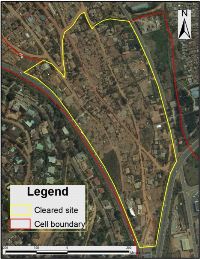
Source: RNRA/lands and mapping department
Batsinda housing project was (still is) targeting low, medium,
and high-cost housing, $10,000 being the maximum for low-cost and$30,000 being
the maximum for medium-cost. The first phase established 250 single-family,
low-cost homes and this was finished with people already relocated into
Batsinda houses from Ubumwe cell. However, only 123 former Ubumwe dwellers
accepted to be relocated out of 250 Batsinda phase I houses (49%), the
remaining 127 houses were given to other vulnerable groups like soldiers,
demobilized soldiers and teachers due to their low income level (Esther,
2009).
The cleared site of Ubumwe cell is now being serviced by
providing roads, street lamps and other basic physical infrastructures (photo
1). Some buildings are being raised while other plots are still vacant. This
redevelopment seems to be slow since there are now 3 years after the relocation
of the residents on that site. According to one of the sector officials in
charge of infrastructure and land management, the redevelopment is relatively
slow because the parcels are very expensive. But the city council says that the
parcels are expensive because of the great expenditures made in servicing land
and providing infrastructures
Photograph 1:Current situation of
the cleared site of Ubumwe
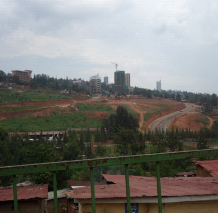
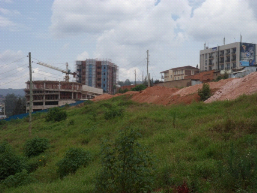
Source: taken by author, October 2011
4.2 Existing
situation of Amahoro cell
4.2.1 Nature of housing
Houses in Amahoro cell are generally characterized by high
density, old roofs and are built with unsustainable materials.
Parcels in this area are very small to the extent that in most
cases the house occupies the whole parcel space with no room for extension,
improvement or for other domestic purposes. Most parcels were acquired before
1990 (65%) and most houses were constructed during this period. Another massive
acquisition of the parcels and construction of new houses occurred between 1995
and 2000 (refer to table 4).
This was the period of the aftermath of genocide and
liberation war during which Rwandese refugees that had fled the country since
1959 and years after, returned to their mother land and had to acquire vacant
land for their establishment since most of them were born and grew in exile and
had no land in the country. The acquisition of land parcels occurred illegally
without prior planning, and in most cases involved dividing the existed land
parcels without respecting minimum parcel size hence creating a slum. Since
2006, the rate of acquiring new parcels in the area and construction of new
houses is very low. This is due to the establishment of the new policies (land
policy, 2005 and Kigali master plan, 2007) that restrict further illegal
housing development.
Table 4: Periods of plot acquisition in surveyed
households
|
Question
|
Response
|
Frequency
|
Percentage
|
|
When was the plot acquired?
|
1960-1970
|
2
|
3.5
|
|
1971-1980
|
21
|
37
|
|
1981-1990
|
14
|
24.5
|
|
1991-1994
|
2
|
3.5
|
|
1995-2000
|
13
|
22.8
|
|
2001-2005
|
3
|
5.2
|
|
2006-2011
|
2
|
3.5
|
|
Total
|
57
|
100
|
Source: survey, 2011
N.B only 57 households responded to this question out of
100 that were asked
Building materials of the houses are unsustainable and old.
The roofing materials (100% iron sheet) have changed their original color due
to rust as a result of long time exposure to elements of rusting without
replacement. Most iron sheets disintegrated and the owners use stones or other
high-density materials to support them (see photo 2).
Photograph 2: Stones supporting
old iron sheets
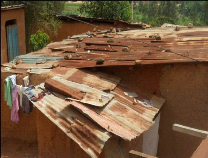
Source: Author, 2011
Walls of most houses are built in mud bricks (53%), 28% in
earth and wattle, 15% in burnt bricks and the remaining 4% in cemented blocks
(figure 5).
Figure 4: Type of building materials of walls of
houses
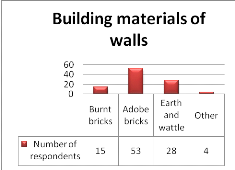
Source: Household survey
2011
According to the regulations of Kigali city council, no house
upgrading that involves changing its shape and size that can be made without
written authorization from the relevant officials at the district. This,
together with poverty, has restricted upgrading by some residents and their
houses are wearing out and slowly falling down (photo 3).
Photograph 3: A house gradually
falling down
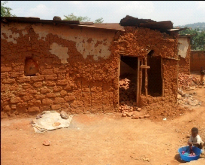
Source: Author, 2011
4.2.2 Physical and social
infrastructure
According to the urban, financial and organizational audit of
Nyarugenge district by the ministry of infrastructure, Muhima sector where
Amahoro cell is found has 52 Ha of surface area that was settled spontaneously,
with a population of 8765 living in this spontaneous settlement (MININFRA,
2009). Muhima sector has a housing density of 120 houses per Ha. But in some
cells such as Amahoro (the case study), Nyabugogo and former Ubumwe informal
residential area the housing density is higher. Amahoro cell has one paved road
crossing the cell from Kacyiru in Gasabo district to the city centre, another
one crossing it along the wetland from Kimicanga through Ubumwe cell to
Nyabugogo (figure 6) and 3 other unpaved roads feeding different villages of
the cell.
Figure 5: Orthophoto showing roads crossing Amahoro
cell
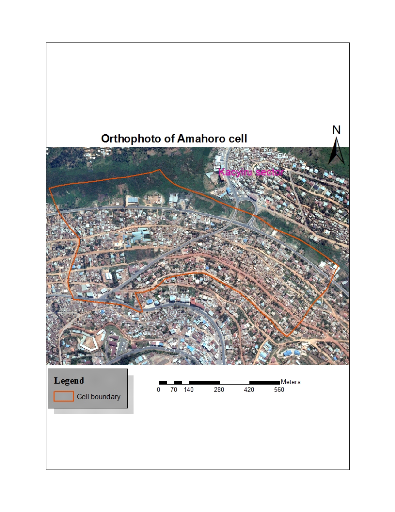
Source: Rwanda Natural Resources
Authority
Amahoro cell has one hospital (Muhima hospital), five churches
and no public water collection. People fetch water from poor sanitary sources
such as wetlands (photo4).
Photograph 4: Source of water in
Amahoro cell

Source: Author, 2011
The above photograph shows the common place near the wetland
where households without piped water supply in their homes fetch. Water fetched
here is not pure since comes from an open source and it becomes worse
especially when it rains.
The drainage system in Amahoro cell is not well constructed.
Most of the gutters channeling rain water and sewage from households are
exposed and gradually expand attacking nearby buildings (photo 5). These
gutters (Ruhurura) have bad odor which affects people close to them and worse
enough they drain in the wetland affecting the ecosystem.
Photograph 5: State of the
drainage system
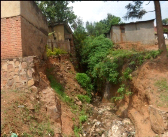 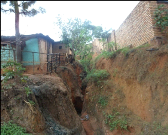
Source: Author, 2011
4.3 Planning
implications of Amahoro cell
According to Kigali city subarea master plans, Amahoro cell
like other parts of Muhima sector is planned for multi-storey buildings for
commercial and institutional services (commercial business district, CBD).
Currently, Amahoro cell is occupied by informal residential houses with
unsustainable building materials. According to the level of income of the
residents in Amahoro cell where 68% of the households earn less than 50,000
Rwandan francs per month, they are not able to construct houses that comply
with the required standards.
In 2008, Kigali city council valuated immovable properties of
residents in both Ubumwe and Amahoro cells. However, Ubumwe residents were
compensated and resettled to Batsinda (a housing project initiated by Kigali
city council, Rwanda Social Security Board and Rwanda Housing Bank) but
residents in Amahoro cell were not paid.The cell executive secretary said that
after expropriating Ubumwe cell residents, the city council saw that the
acquisition of plots by investors was slow and decided not make more mass
expropriations. When an investor needs to acquire land, then he/she
expropriates the land owners occupying the surface area that he wants to cover.
According to law No. 18/2007 of 19/04/2007 chapter 3, section3, article17
relating to the expropriation in public interest, `The owner of the land is not
allowed to carry out any activities after the land survey and the inventory of
the properties thereon and coming to terms with the beneficiaries. In case he
or she carries out any activities, they shall not be valued in the process of
expropriation'. This hindered residents who were able to upgrade their houses.
Time came when this step of land survey and inventory of the properties towards
compensation and relocation lost validity. But residents are still bound by the
regulation of Kigali city council which states that no new building should be
erected in the area without prior authorization from the district which
confirms that the building conforms to the requirements by the master plan.
Upgrading the house by changing the shape and size of the building is not
acceptable and any upgrading is authorized by the district.
However, recently Kigali city council took a decision to
improve the city's sanitation and physical outlook by mobilizing all residents
to remove all stones, metallic objects and other woody materials that were put
on roofs to support old iron sheets and paint them (photo 6). These measures
are taken to keep the city clean while in the transition of implementing Kigali
conceptual master plan.
Photograph 6: House under roof
painting
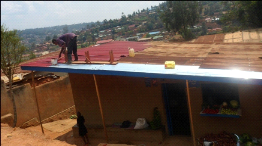
Source: Author, 2011
4.4 Resident's
perception on informal housing upgrading and master plan implementation
Urban renewal involves upgrading of the existing urban
buildings and structures or clearing the existing informal settlements for new
developments. The latter is planned to be implemented in Amahoro cell according
to the subarea master plan of Muhima sector. One of the objectives of this
research was to assess Amahoro residents' perception on this renewal envisaged
in the master plan and what they would demand if susceptible to expropriation
or relocation.
4.4.1 Perception on Kigali master
plan
Generally residents admit that the nature of housing in their
neighborhood is not good depending on the sustainability of the building
materials, minimum parcel size and basic infrastructure provision and
accessibility. About 73% of the surveyed households responded that the nature
of housing in their neighborhood is poor while only 27% said that their
neighborhood is good in terms of housing development (table 5).
Surveyed households said that they have heard about Kigali
conceptual master plan and that their neighborhood will be developed into a
business centre with multi-storey buildings. They also said that KCMP is one
way and a step towards achieving Rwanda's vision 2020 for its citizens. They
further said that its implementation will lead to the country's overall
development through enhancement of commercial services and extension of both
physical and social infrastructure.
However, they added that the implementation of the master plan
will displace them to the city's periphery which will hinder accessibility to
their jobs in the city centre.
Table
5: Residents' judgment on the sustainability of building materials in their
neighborhood
|
Question
|
Response
|
Frequency
|
|
Nature of housing in the neighborhood depending on the
sustainability of building materials
|
Poor
|
73
|
|
Good
|
27
|
|
Total
|
100
|
Source: Household survey,
2011
4.4.2 Perception on expropriation
process and relocation
According to the law relating to expropriation in public
interest no. 18/2007 of 19/04/2007, expropriation is carried out by the
government only in public interest and with prior and just compensation. No
person shall hinder the implementation of the program on pretext of self
centered justifications. No land owner shall oppose any underground or surface
activity carried out on his or her land with an aim of public interest. In case
it causes any loss to him or her, he or she shall receive just compensation for
it.
Depending on this law, the researcher had an objective (among
other objectives) of assessing residents' views on expropriation and their
willingness to resettlement once the government need to acquire their land for
development in public interest. Residents have different views on new housing
development taking place in Kigali city. Some residents say that the new
housing development intends to evict them since they are poor and cannot build
houses with the required minimum standards (see table 6 below). However the
majority of these with fear of eviction are tenants. Others have the view that
once the government takes their land for new development, they will be
compensated and find elsewhere to establish new homes in the city. The majority
with this view are land owners who think that when given just compensation they
can build or buy new comfortable and affordable houses in another residential
area established by the city council.
The remaining percentage of interviewed residents said that
they hope to get a new decent house once the government acquires their land for
new development in public interest. Residents with this view are those with
poor houses on a very small plot of land who think that compensation from their
properties cannot allow them buy or build a new house in the city. So,
according to them, the relevant authorities should take their land showing them
a ready new house to occupy.
Table
6: Residents' perception on implementation of KCMP
|
Question
|
Response
|
frequency
|
|
How do you think the implementation of KCMP will affect
you?
|
Will evict me
|
47
|
|
Will expropriate me
|
33
|
|
Provide me a decent house
|
20
|
|
Total
|
100
|
Source: Household survey,
2011
According to the expropriation carried out in Ubumwe cell and
in some other parts of Kigali city, some expropriated persons were assisted to
get new houses constructed by Kigali city council in collaboration with other
housing partners. Batsinda housing estate established by Kigali city council in
partnership with Rwanda Social Security Board and Rwanda Housing Bank to
receive expropriated persons from Ubumwe cell were resettled.
However, not all of them went to Batsinda because some of them
were not satisfied with the size, location and standard of the houses in
Batsinda. To know what residents of Amahoro cell would prefer if susceptible to
relocation, they were asked whether they would accept compensations for their
properties alone and look for other houses for themselves, compensations and a
serviced plot so that they can construct a house of their choice or be
compensated and assisted to get a new subsidized house which they would pay in
installments. The chart below shows their responses.
Figure 6: Residents' preferences if susceptible to
relocation
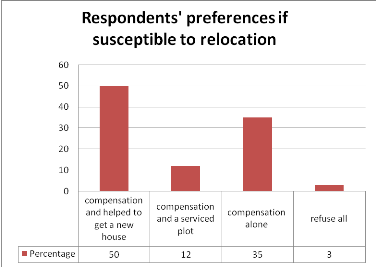
Source: Household survey
2011
As it is obvious in the chart above, a half of the respondents
(50%) need to be assisted to get a new house instead of giving compensations
for their properties alone. The reason they put forward is that they are poor
and have poor quality of houses which would be compensated little money that
can only buy a plot of land without a house. They also added that compensation
prices are low while the prices of houses and plots increase as the demand
increases. The following chart reveals residents' judgments on the
expropriation prices in Kigali city.
Figure 7: Residents' perception on expropriation
prices in Kigali city
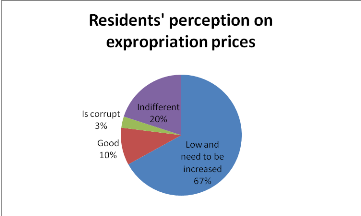
Source: household survey
2011
Kigali city land commission approved Kigali expropriation
prices in July 2008 (see Annex 3) which were used when expropriating Ubumwe
cell residents and are still applied to date. Unfortunately the prices on the
land and housing market increase frequently. This seemingly fixed price does
not favor expropriated persons because they cannot easily get an equivalent
plot of land and be able to construct a new building especially for the already
poor residents.
4.5 Housing
regulation in Kigali city
Before the establishment and approval of Kigali conceptual
master plan in 2007, there was no specific guiding blueprint for housing and
infrastructure development in Kigali city apart from broader policies, laws and
regulations (established by the city council) to control housing development.
Regulations by Kigali city council had their basis on the laws and policies in
place established by the government. These regulations were implemented by the
lower local government authorities (districts, sectors, cells and Imidugudu).
The regulations were not fully enforced by all local leaders since some of them
(local leaders) were influenced by corruption and could tolerate illegal
buildings. This led to the continuous growth of informal settlements even
though these regulations and laws were in place. Below we discuss some of the
policies and laws that are based on to regulate housing development in Kigali
city:
A national consultative process that took place in village
Urugwiro in 1998-99 resulted into Rwanda's vision 2020. This vision is a basis
for policies and laws developed since its establishment. Vision 2020
acknowledges that Rwanda is characterized by low but accelerating urbanization.
This has happened in a rapid and uncoordinated manner, meaning
that social services and employment opportunities are lagging behind. Vision
2020 anticipated that from then (1999) until 2010,each town will have regularly
updated urban master plans and specific land management plans.
It is in line with vision 2020 that Kigali conceptual master
plan was established in 2007 and district municipal master plans. According to
Kigali conceptual master plan, a long range vision for how development might
occur over the next 50-100 years to accommodate another 2-3 million people is
provided. While this might seem like a long time into the future, urban
planning experience shows that by establishing along range plan for key
infrastructure and systems early on, they can guide future incremental growth
with carethoughtfulness, concern for real human needs, citizen participation,
cost effectiveness and efficiency.
The goal of this plan is not to control the growth of Kigali
in an authoritarian way, but to provide the framework and flexibility to prompt
a long term process that is guided by Rwandans as they shape their capital city
incrementally, responding to changing needs; and that creates a vibrant, unique
and truly Rwandan city. Subarea master plans have been established for
different parts of Kigali city while others are underway. Implementation has
already started in some areas such as Muhima, Akumunigo in Nyamirambo, and
Kimicanga. Any building to be erected must conform to the respective subarea
master plan. In case land is needed for the development in public interest, it
is acquired from private owners through expropriation. The expropriated persons
are relocated to a new site primarily designed for residential use. An example
is the relocation of former residents of Ubumwe cell in Muhima sector to
Batsinda in Kinyinya sector of Gasabo district.
Unlike in the past, no new building or even any upgrading on
the existing building can be done without the building permit from the relevant
officials at the district level. In case a person wants to build a house or
upgrade his/her house must pass through the Umudugudu, cell and sector
officials who confirm that the land belongs to that person and that it is found
in that area where he/she wishes to build the house. When the seeker of the
building permit meets the requirements, he/she is given an authorization.
Leaders at the Umudugudu must make thorough supervision to ensure that no
building is erected without the license from the district. Any building found
to have been erected without authorization is demolished by the sector
officials with permission from the district. These procedures are more
respected by local authorities than in the past because any illegal tolerance
is punished by law.
In 2008, national urban housing policy was established to
guide Government objectives and priorities in line with the objectives as laid
down particularly in the Vision 2020, the EDPRS, and the National Investment
Strategy (MININFRA, 2008). According to the aims of Vision 2020, about 30% of
the population will live in planned cities with access to basic infrastructure
necessary to ensure sustainable development. This policy proposes the
establishment of a regulatory body, an Urban Development Board to manage the
development of urban areas and urban housing in particular. This body will
regulate the issues concerned with allocation of land, its development,
standards associated with housing and construction, private and public estate
development among other functions.
Two years after the establishment of the national urban
housing policy (2010), Rwanda housing authority was established as a public
institution to implement the national housing and construction policy through
coordination, conception, development, monitoring and evaluation of actions and
programs set out in its mission. Currently in its early stage of work, the
Rwanda housing authority (RHA) evaluates district municipal land use master
plans and is setting relevant regulation documents. Rwanda housing authority
serves as the overall project manager on the behalf of the state for all
projects related to housing and construction.
4.6 Impact of new
housing policies on unplanned settlement dwellers
4.6.1 Positive impacts
Housing development in Kigali city according to the master
plan will greatly change its image and the living conditions of its citizens.
The implementation will lead to the dissolution of slums and upgrading of
informal settlements. Poorly developed prime land will be redeveloped to
maximize investments hence economic growth. Also land use zoning will allow
maximum and efficient use of land while giving Kigali city an aesthetic
physical structure.
According to the surveyed residents in Amahoro cell, they
expect improved lifestyle as a result of new housing development. Some of them
said that when expropriated they will buy land and practice agriculture which
will help to improve their living conditions. Others said that expropriation of
their properties for new housing development will help them buy new houses of
their choice.
Kigali city officials emphasized the accommodation of a fast
growing population of Kigali that will result from the development of
apartments and zoning specific areas for residential use, industrial or
commercial uses. According to the personnel in charge of social affairs in
Muhima sector, the construction of apartments will shelter many families on a
small surface area than it is for detached houses. One of the officials in
Rwanda housing authority in urban planning unit said that planned housing
development will ease the provision of infrastructures such as roads, water
supply, electricity connections and development of the green spaces. He further
added that planned settlements will lead to better land management and
efficient waste evacuation systems.
4.6.2 Negative impacts
On the side of the Kigali city council, the implementation of
the new housing development as stipulated in the master plan is a fruitful
result. However, on the side of informal settlement dwellers especially those
on prime land that is targeted for redevelopment are worrisome because they are
susceptible to relocation. To these residents, resettlement will affect their
livelihood because they will be taken far from the city centre where they can
earn a living through casual labor and where they easily get to their work.
Asked on what they think would be the negative impacts on
their livelihoods if expropriated, surveyed households in Amahoro cell revealed
that they are worried about the expropriation prices. 48% of the respondents
said that they will not be able to reintegrate themselves in the new area once
they are under-expropriated. They further added that buying a new plot and
erecting a new house is expensive.
The rest of the respondents gave the following as negative
impacts once expropriated: they said `we would be relocated to an area far from
the city centre which may increase transport costs since our jobs are in the
city centre'. Others said that `we initiated long term projects; these may be
affected negatively once we are relocated to a different place'. However, most
of them showed reluctance in their mind towards relocation saying that it is
not easy to admit to shift without knowing where to go, and that separating
with friends is not easily welcomed.
4.7 Housing demand
in Kigali city
Statistics indicate that a single house costs about 20 million
Rwandan francs. This means that total housing demand would require a financing
package of up to 500 billion Rwandan francs per year. In a breakdown, Kigali
city alone demands about 10,000 housing units per annum (MININFRA,
2008).Although the demand for housing has grown, involvement of the public and
private sectors has not improved much from the 10% that was registered in 2003.
Last year alone, the construction growth rate was estimated at 16% (MININFRA,
2008)
Rwanda needs about 25,000 housing units per year, a basic
right for her citizens, quoted in the Istanbul declaration. This estimation is
for urban centers of the country only.Due to the growing demand for housing in
urban areas and the rapid development of slums, planning and organized
settlement is becoming a complicated issue. Moreover, it appears that
urbanization of principal urban centers in Rwanda resulted more from
accumulation of the population often of rural origin, around the structured
city and not from within, thus generating perimeters of sub-urbanized zones
where the density reaches 700 people per km2. This spontaneous
growth of urban centers has led to the breakdown of social functions and
spatial segregation, with land wastage that blocks any attempts for sustainable
development.
4.8 Strategies for
housing low and medium income groups in Kigali city
Kigali as a capital city of a developing country faces many
challenges. The numerous issues impeding Kigali city's growth include
significant lack of infrastructure including water, electricity and waste
management systems, inadequate garbage collection methods, poor drainage, poor
roads, inadequate public transport network, insufficient housing supply and
spontaneous settlements. In order to find solutions for these problems, Kigali
city council is striving to design feasible, cost-effective and fair solutions
through policies, guidelines, new laws and law reforms. With regard to housing
issue, the city council faces a challenge of poor residents in informal
settlements (Utujagari) who are not able to cope with the new housing
development trend in Kigali city as stipulated by the adopted Kigali master
plan.According to the master plan, every citizen of Kigali city will have
access to basic needs and stay in a livable city environment: adequate housing,
education and workplace opportunities, infrastructure and transport, healthcare
and services, and quality of life.
Since a large part of the city is built with informal houses
(above 70%), Kigali city council through different planning project phases is
acquiring private land through expropriation to provide serviced land to real
property investors. However in order to cater for expropriated persons, and
prevent further development of informal settlements, Kigali city council
developed `a model house project' in Kinyinya sector, Gasabo district.
The model house project was used to show that local materials can be used to
build decent and safe low-cost housing for expropriated persons and other
low-income earning groups.The Batsinda housing project was initiated based on
the model house to provide adequate housing and basic infrastructure
to people that were expropriated from Ubumwe cell in Muhima sector as discussed
in section 3.1 above.
Consequent to the CBD and Kimihurura gateway development
projects for the transformation of prime land currently populated by slums into
profitable schemes for maximum use of the land, there has been a challenge of
providing alternative good quality yet affordable housing with all amenities to
the people. However, projects are being developed for profits gained from these
schemes to be applied in the development of subsidized and planned residential
hubs for the relocated residents. These are Akumunigo and Kinyinya residential
hubs which will exhibit easy accessibility to all services such as banking,
shopping, recreational, income earning opportunities among many.The Kinyinya
residential township project emphasizes adequate housing availability for city
dwellers over an area of 338Ha. This scheme is to cater for all income brackets
hence the term affordable housing. Kigali inner city is characterized by
approximately 50% of informal and indecent settlements that need to be
addressed.This does not rule out the different slums in the other parts of the
city, however, the inner city slums are being immediately addressed because
some of them have been established on prime land for modern development in the
Central Business District.
Kinyinya residential township project commenced in January 2009
through a first phase that will cover an area of 26Ha and provide a total of
10,350 units. The figure below shows the housing prototype for Kinyinya
residential township. As it is obvious from the figure below, many families
will be accommodated in one multi-storey building hence reducing the surface
area of the built environment and the scarcity of land.
Figure 8: Housing prototype for Kinyinya residential
township
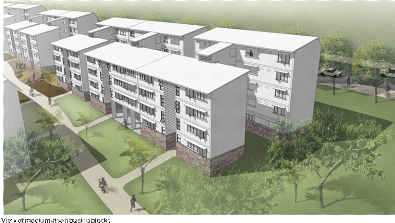
Source: Kigali city 2008;
Urban renewal projects
4.9 Major housing
developers in Kigali city
Apart from self provision of housing units by individuals in
Kigali city (and they are the majority), there are both public and private
institutions (firms) that play a significant role in real estate
development.Rwanda social security board (RSSB) is the major public institution
that has concentrated efforts and finance in real estate development especially
in residential housing development. One of the Rwanda social security board's
developments is Gacuriro estate in Kinyinya sector of Gasabo district. Gacuriro
estate is a well developed residential site with basic infrastructures such as
paved roads and streets, electricity and water connections (photo 7). There are
302 houses that were built in 2003 on Gacuriro estate site. It is said that
these houses were built to facilitate low-income people to own a shelter.
However, the standard and cost of houses built by RSSB in Gacuriro seem to be
high compared to income of the majority of Kigali residents. Rwanda Social
Security Boardsold each house at a cost of 23 million Rwandan francs with 5
million paid in advance. The rest of the money could be paid in installments.
Houses that were not bought are being rate rented at a price of 1200$ per
month.
Photograph 7: Gacuriro houses
built by RSSB
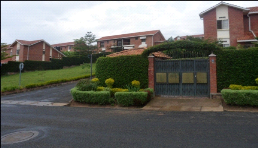
Source: Author, 2011
Rwanda Social Security Board is undertaking another housing
project scheme of 2600 in the same area. Private land owners were compensated
according to the expropriation law of Rwanda.
Kigali city council (KCC) has also contributed to the housing
of its low-income citizens especially those displaced (relocated) by
expropriation in public interest. To provide affordable housing to low-income
groups, KCC developed `a model house' constructed using sustainable
low-cost materials (photo8). In the first phase, 250 low-cost model houses were
constructed in Batsinda, Kinyinya sector in Gasabo district. The site is
provided with a school health center, roads, electricity and water. KCC
resettled residents that were expropriated in Ubumwe cell, Muhima sector in
Nyarugenge district. The cost of each house was 10,000$. The cost was somehow
affordable to poor families since they were assisted to pay, through
collaboration of Kigali city with Rwanda Housing Bank (RHB) which provided
loans. Even though somehow affordable in terms of cost, some occupants claim
that a two-bedroom house is too small for large families. KCC is planning to
build more houses in the following phases.
Photograph 8: Batsinda model
house
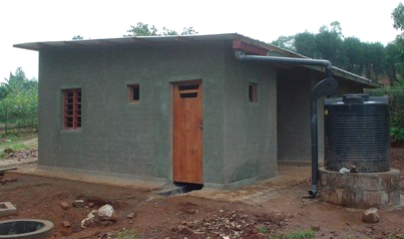
Source: Kigali city website
(www.kigalicity.rw)
Rwanda Housing Bank (RHB) is a public financial institution
that was established by the government to finance housing development in
Rwanda. The institution basically provides loans to individuals who want to
build their houses. The Rwanda Housing Bank normally gives loans to individuals
that want to purchase, complete or upgrade their homes. Also the bank provides
loans to property developers wishing to construct houses for sale. The
developers should have a 40% of the project cost; while the bank gives a loan
of 60% (the bank offers loans to qualifying buyers as well). However the bank
also developed 52 houses in Gacuriro that were sold to individuals.
Some public institutions, like the national bank of Rwanda,
have built houses for their employees to facilitate them to own a shelter. This
has contributed to housing ownership by most public servants.
In addition to housing development by public institutions,
there are private estate developers that build houses and sell or rent them to
individuals. Kigali top mountain company is one of them and has constructed 58
houses in Gacuriro cell. The Kigali top mountain company is opting to widen its
housing supply in Kigali city. Another private company that constructs houses
for sale is real constructors, the proprietor of Kabuga hillside estate. The
new Kabuga hillside estate located in Rusororo (Gasabo district) enjoys a range
of residential pleasures. Kabuga hillside estate is located 7 kilometers from
Kigali international airport. It has 79 units each with 4 bedrooms on spacious
25x25m plots.
A general observation is that most houses built by either
public or private firms (or institutions) are expensive and cannot be bought by
most low-income earners in Kigali city.
4.10 Challenges in new housing development in Kigali city
The main challenge in the new housing development is a large
number of informal settlement quarters on prime land that need to be
expropriated for efficient redevelopment. In an interview with an official in
charge of housing in Kigali city, he said that expropriating and redeveloping
land by providing basic amenities such as plot servicing, roads, electricity
and water supply, is an expensive multimillion project. This could delay the
implementation of the housing development.
Poverty is another big challenge to this development since the
majority of residents in informal settlements are poor. Apart from some
informal settlement quarters on prime land that need to be removed for renewal,
there are others that need to be upgraded as proposed in the master plan. But
this upgrading is a threat to the poor residents.
Another important challenge that cannot be left behind is the
poor terrain in most parts of the city. Erecting multi-storey buildings
requires that land must be flattened. This is expensive because about 50% of
land in Kigali city is on poor terrain.
Resistance to new changes by residents; normally people are
reluctant to relocate because they are not sure whether life will proceed as
they used to do. In this case, some people have fear of relocating without
knowing where to go for resettlement. As a result, they go in the city
peripheries and develop new informal settlements.
Increased rental prices; 57% of surveyed households are
tenants and in expropriation they are released to find another rent. This
increases the prices since the number of seekers is bigger than the available
houses for rent.
Lastly, as discussed in section 3.3 above, residents claim
that the expropriation prices are low such that it is not easy to re-establish
in a new area with a decent house and lifestyle. Even if assisted to get
already constructed houses, they are not satisfied with the standard and size.
Considering Batsinda housing estate built for people expropriated in Ubumwe
cell, the majority refused to acquire them saying that they are small and of
low standard.
5 CONCLUSION AND RECOMMENDATIONS
6 Conclusion
As the main objective of this research was to assess the
challenges in the transition from unplanned settlement to new housing
development in Kigali city, variables such as residents' perception and
awareness were measured against expropriation policy in line with the
implementation of the Kigali conceptual master plan. Amahoro cell in Muhima
sector where this research was carried out is one of the quarters planned for
the development of the CBD1. Residents were asked about what they think is the
master plan & its importance, expropriation process and relocation with
regards to the experience of their neighboring Ubumwe cell.
Household survey revealed that 73% of the respondents
recognize that the nature of housing in their neighborhood is not good in terms
of planning and the durability of the building materials. They said that at
least they have heard about the master plan and the planning implications of
their area since their properties were surveyed for expropriation in 2008 but
they were not expropriated and the survey lost validity to date. Constructing a
new residential house in this area is not easily acceptable until residents are
expropriated and the land is developed for commercial purposes.
Concerning the effect of implementing the master plan in their
area, 47% of the surveyed households revealed that they will be evicted.
However, these are tenants who have no immovable properties in the area. 33%
have the perception that they will be expropriated to allow the government
implement the master plan. But 20% of the surveyed residents showed a strong
belief and hope that during expropriation the government will provide them new
decent houses in another area better than the ones they are living in. people
with this perception are those with little monthly income and relatively
families in poor housing.
About 50% said that they would prefer compensation of their
properties and helped to get a new house if susceptible to relocation because
re-establishment in 90 days provided by the law to have shifted after
expropriation would not be easy for them. Another 12% said that they would
prefer expropriation of their properties and assisted to get a serviced plot
where they can build a house of their choice relative to their financial
capacity and family size. And 35% said that they would prefer compensation
alone and re-establish themselves in a new area of their choice, while 3% said
that they would refuse any attempts to relocate them because they have the
rights on their land.
Also results showed that 67% of the surveyed households
regarded the expropriation prices in Kigali city to be low by considering the
experience in Ubumwe cell. They added that the prices seem to be fixed while
the land and housing costs increase frequently in the city.
Regarding the impacts of implementing the new housing
development on unplanned settlement dwellers, research revealed that there are
both positive and negative impacts: positively, residents expect improved
lifestyle and sanitary conditions as a result of new housing development.
Negatively, relocation to a new area for new developments will affect residents
who already have their jobs in the current area of residence by losing them or
by increased transport costs.
Lastly, the results showed that the main challenges to the new
housing development in Kigali city are lack of enough capital to expropriate
residents in informal settlements and help them get new residences, poverty
among residents, poor terrain in some areas and resistance to change by some
residents.
6.1
Recommendations
As Kigali city is undergoing renewal and upgrading projects,
it is important to take into consideration the needs and expectations of its
residents; low, medium and high income classes. Before carrying out
expropriation, prior consultation of the stakeholders should be held to raise
people's awareness about the importance of the project. Surveyed residents gave
the following as recommendations to Kigali city council and other housing
partners in the housing development:
Kigali city council should build houses of different standards
instead of single-fashioned category of houses so that expropriated persons may
make choice depending on the family size and financial status. This would
reduce dissatisfaction of expropriated persons.
If a certain area is planned for a given land use and the
occupants must be expropriated, expropriation should be carried out when the
city or other investors are ready to develop the land. This would avoid
relocating people in a hurry saying that the land is going to be developed in
public interest, and the land takes more than two years without development-
like the case of Ubumwe cell.
In order to prevent new developments of informal settlements
in the city's periphery, poor expropriated persons should be helped to get
already built houses in appropriate serviced residential area. This can be
helpful if they can pay back in installments when assisted to get a source of
income.
Since there are a big number of tenants in informal
settlements susceptible to displacement as a result of expropriation of houses
of their landlords, the Kigali city or expropriators should build multi-storey
apartments to accommodate tenants and other expropriated persons that may wish
to settle in apartments. This would also reduce the built surface area.
Zones planned for residential purpose should be prepared by
constructing basic amenities such as schools, health centers, roads, markets,
electricity connections and water supply and other basic services to attract
people. In this case plots should be left vacant so that people build standards
of their choice according to the zoning plan.
Thorough mobilization of the residents should be done before
expropriating them to raise their awareness and should be informed earlier
before expropriation so that they may be able to appraise among the
alternatives.
Expropriation prices should be revised each year in order to
match with the current costs of building materials and the cost of land.
To interested researchers, more research should be done to
analyze how expropriation procedures in Kigali city affect urban planning and
development.
Reference
Bond, T. and Tait, A. (1997). The failure of housing policy in
South Africa. Urban forum, 8(1), pp.19-41.
Cohen, M. (2004). Proposed argument for the UN-Habitat global
report on financing urban development. A discussion paper presented at the
global research network on human settlements (HS-Net). Nairobi, 1-3 November,
2004.
Durand-Lasserve, A. (2007). Market-driven eviction processes
in developing country cities: The cases of Kigali in Rwanda and Phnom Penh in
Cambodia, World Bank-IPEA international urban research symposium, 3(1). Global
urban development (GUD) magazine.
ECA and UN-Habitat (2008). The state of African cities: a
framework for addressing urban challenges in Africa. UN-Habitat, Nairobi.
Esther, B.M., (2009). Assessing the level of community
participation in a resettlement project and its impact on project
successfulness: a case of Ubumwe-Batsinda project Kigali-Rwanda. Msc thesis.
Rotterdam. Netherlands
Ilberg, A., (2008): Beyond paper policies: planning practice
in Kigali
Martin, T. (2007). Kigali urban development plan is a tough
task: The New Times. Retrieved May 28, 2011, from
http://allafrica.com/stories/200704300240.
Millennium project (2005). A home in the city: Achieving the
millennium development goals. Earthscan, London.
MININFRA, (2007). Kigali City Master Plan: Existing Condition
Analysis; Prepared by the Master Plan Team for the Ministry of Infrastructure;
Kigali.
MININFRA, (2008). National urban housing policy of Rwanda.
Kigali, Rwanda.
MININFRA, (2008): National urban housing policy for Rwanda.
Kigali, Rwanda
MININFRA, (2009). Infrastructure and urban management program:
urban, financial and organizational audit for Nyarugenge district. Kigali.
MININFRA, (2009): Rwanda national construction industry.
Kigali
Republic of Rwanda, (2000). Rwanda vision 2020. Kigali,
Rwanda.
Republic of Rwanda, (2010). Law No. 40/2010 of 25/11/2010
establishing Rwanda housing authority (RHA) and determining its
responsibilities, organization and functioning. Kigali: official gazette no.19
0f 28/02/2011.
Smit, W. (2000). The impact of the transition from informal
housing to formalized housing in low-income projects in South Africa: paper at
the Nordic Africa institute conference on the informal and formal city, 15-18
June 2000, Copenhagen.
UN-Habitat, (2003). The challenge of slums/Global report on
human settlement. UN-Habitat, Nairobi. Earthscan, London.
UN-Habitat, (2011). Housing the poor in African cities:
Alternatives to the destruction of urban poor communities. UNON publishing
services section. Nairobi.
UN-Habitat, (2011). Losing your home: Assessing the impact of
eviction. UNON publishing services section. Nairobi.
Yamen, T. (1967). Statistics: An introductory analysis
(2nd Ed.). New York: Harper and Row.
Web sites
1.
http://en.wikipedia.org/wiki/Slum_upgrading,visited on 14th
September 2011
2.
http://legal-dictionary.thefreedictionary.com/Public+Interest, visited on
14th September 2011
3.
http://www.businessdictionary.com/definition/expropriation.html, visited on
14th September 2011
4.
http://www.investorwords.com/13860/slum_clearance, visited on
14th September 2011
5. http://www.answers.com/topic/master-plan, visited on
14th September 2011
ANNEXES
Annex 1: Questionnaire for
residents
<FROM UNPLANNED SETTLEMENT TO NEW HOUSING DEVELOPMENT
IN KIGALI CITY>
Questionnaire for residents in Amahoro cell of Muhima
sector
Dear respondent, my name is MUGISHA John, a student at the
national university of Rwanda in the department of geography. I am conducting a
research on unplanned settlements in Amahoro cell with the objective of
`assessing the challenges of the transition from unplanned settlement
to new housing development in Kigali city'
Questions for this research are solely intended to fulfill the
academic requirements for a bachelor's degree at the national university of
Rwanda in geography department. Your responses and feelings will only be used
for academic purposes.
IDENTFICATION:
1. Name of the respondent (optional):
...................................................
2. Village (Umudugudu):
................................................................
3. Cell:
....................................................................................
QUESTIONS:
A. OWNERSHIP STATUS
1. Is this house your own? Or you pay rental fees?
a. My own b. rent
2. Use of the house:
a. Residential b. commercial
c. Residential and Commercial
3. If it is your own, when did you acquire the plot?
a. 1960-1970 b. 1971-1980 c.
1981-1990 d. 1991-1994 e. 1995-2000
f.2001-2005 g.2006-2011
4. How did you get your plot?
Through: a. purchase b. inheritance
c. gift d. the government
e. squatting
f. Other Specify:
.................................
5. Do you have any legal property document of the plot? Yes
No
If yes, specify the document(s):
.....................................................................
6. Do you hold a building permit? Yes
No
7. Which administrative level issued the permit?
a. Umudugudu b. cell c. Sector
e. District f. Kigali city council
g. Other:
.............................................................................
B. NATURE OF THE HOUSE
8. Roof: a. iron sheet b. clay tiles
c. other: ...............................................................
9. Wall: a. burnt bricks b. Adobe bricks
c. earth and wattle d. other: ...........................
10. Floor: a. earth b. cement c.
Tiles d. other: ........................................
C. RESIDENT'S PERCEPTION ON NEW HOUSING DEVELOPMENT IN
KIGALI CITY
11. Employment status of the head of household
a. Public employee
b. Private organization employee
c. Self-employed
d. Casual laborer
12. What is the total number of household members?
a. 1-3
b. 1-5
c. 1-7
d. 1-9
e. <9
13. How much money is earned by the household per month?
a. Less than 10,000 Rwf
b. Between 10,000 and 50,000 Rwf
c. Between 50,000 and 200,000 Rwf
d. Between 200,000 and 400,000 Rwf
e. More than 400,000 Rwf
D. RESIDENTS' PERCEPTION ON NEW HOUSING DEVELOPMENT IN
KIGALI CITY
14. How do you judge the state of housing in your
neighborhood?
a. Poor
b. Good
c. Very good
15. Kigali city is implementing its conceptual master plan.
What does it mean to you?
...............................................................................................................
.....................................................................................................................
16. What do you think is the importance of the master plan?
.................................................................................................................
17. How do you think the implementation of Kigali conceptual
master plan will affect you?
It will: a. evict me b. expropriate me
c. build a decent house for me
18. If your plot is susceptible to expropriation in public
interest, what would you prefer?
a. Compensation and helped to get another house
b. Compensation and helped to get a serviced plot
c. Compensation alone
d. Refuse
19. What do you think would be the impacts on you if
expropriated?
....................................................................................................................
...................................................................................................................
20. Former residents of Ubumwe cell who were relocated to
Batsinda complain that they were paid cheaply and that Kigali city wanted to
make enormous profits from Ubumwe cell. What is your perception on this
matter?
a. It is true
b. It is false
c. They were paid fairly
d. Indifferent
21. What would you demand if you were among expropriated
residents of Ubumwe cell?
......................................................................................................
22. How do you judge the expropriation process in Kigali city?
The expropriation cost is:
a. Low b. good c. need to be
increased d. involves corruption
23. What challenges do you envisage in the new housing
development in Kigali city?
..................................................................................................................
.....................................................................................................................
24. What do you recommend the Kigali city council towards
decent housing?
a.
...............................................................................................................
b.
...............................................................................................................
Thank you very
much!
Annex 2: Questionnaire for
local leaders
<FROM UNPLANNED SETTLEMENT TO NEW HOUSING DEVELOPMENT
IN KIGALI CITY>
Questionnaire for local leaders in Kigali
city
Dear respondent, my name is MUGISHA John, a student at the
national university of Rwanda in the department of geography. I am conducting a
research on unplanned settlements in Kigali city with a case study of Amahoro
cell, with the objective of `assessing the challenges of the transition
from unplanned settlement to new housing development in Kigali city'.
Your responses will serve a great deal towards achieving this
objective.
IDENTIFICATION:
a. Position:
...........................................................................
b. Administrative level:
.....................................................
QUESTIONS:
1. According to the national housing policy for Rwanda, 80% of
Kigali is composed of unplanned settlements. Is this a problem to housing
development in Kigali?
a. Yes
b. No
2. If the previous answer is yes, how is informal settlement
defined in Kigali city?
............................................................................................................................................................................................................................................................................................................................................................................................................
3. Is housing development at a good stage in Kigali city?
a. Yes
b. No
4. If yes, how? If no, why?
...........................................................................................................
...........................................................................................................
...........................................................................................................
...........................................................................................................
5. If yes, what are the main factors that are helping housing
development to boost?
...........................................................................................................
...........................................................................................................
........................................................................................................................................................................................................................
6. If no, what are the main factors that hinder the housing
development industry in Rwanda?
....................................................................................................................................................................................................................................................................................................................................
7. In line with the implementation of the KCMP, Kigali master
plan implementation projects have been developed starting with immediate
developmental zones. Is this redevelopment clearing or relocating the existing
informal settlements?
....................................................................................................................................................................................................................................................................................................................................
8. If the previous answer is yes, who are the main
stakeholders in this redevelopment project?
....................................................................................................................................................................................................................................................................................................................................
9. Could you explain the main stages in this redevelopment
project implementation and relocation/expropriation of existing unplanned
settlements?
....................................................................................................................................................................................................................................................................................................................................
10. Are there problems that you faced in redeveloping Ubumwe
cell zone?
a. Yes
b. No
11. If the previous answer is yes, which ones?
..........................................................................................................................................................................................................................................
12. How many households in that were relocated from Ubumwe
cell?
.....................................................................................................................
13. What have been planned for them?
........................................................................................................................................................................................................................
14. Where are they actually living?
...........................................................................................................
15. What challenges are they facing?
........................................................................................................................................................................................................................
16. According to Kigali conceptual master plan, a bigger part
of Muhima sector (150 Ha), and Amahoro cell inclusive, is planned for the
central business district (CBD1). Yet, at present there is a large living in
informal settlements. What do you plan for them?
a. Expropriating them
b. Upgrading their houses
c. Relocating them
d. Evicting them
17. Is there another site that will receive expropriated or
evicted residents from the central business district zone?
a. Yes
b. No
18. If yes, where will be the site?
............................................................................................................
19. What strategies are you using to implement the new housing
development in Kigali city according to the master plan?
a.
......................................................................................................
b.
.........................................................................................................
c.
.........................................................................................................
20. What challenges do the implementation of these strategies
face?
a.
.........................................................................................................
b.
.........................................................................................................
21. What do you think will be the impacts of implementing
Kigali conceptual master plan on the residents in informal houses?
a. Positive impacts
i.
.............................................................................................
ii.
.............................................................................................
iii.
.............................................................................................
b. Negative impacts
i.
.............................................................................................
ii.
............................................................................................
iii.
...........................................................................................
22. What does the plan to overcome the negative impacts?
a.
....................................................................................................................................
b.
...................................................................................................
23. What would you recommend the residents or the Kigali city
council for decent and socially inclusive housing?
a.
...................................................................................................
b.
...................................................................................................
Thank you for your time!
ANNEX 3:Compensation
prices
KIGALI CITY EXPROPRIATION PRICES AS APPROVED BY KIGALI CITY
LAND COMMISSIONS TO BE USED WITH IN THE BOUNDARIES OF LIGALI CITY WITH EFFECT
FROM JULY 2008.
NB: the following table shows an extract of land expropriation
prices in Muhima sector. The expropriation prices are valid only in case of
public interests.
|
Sector
|
Cell
|
Land price/m2
|
Land located along stone made road
|
Price of land/m2 located along stone made
road
|
Land located along tarmac road
|
Price of land/m2 located along tarmac
road
|
|
Muhima
|
Rugenge
|
1,950
|
1.25
|
2,438
|
1.5
|
2,925
|
|
Muhima
|
Kabeza
|
1,800
|
1.25
|
2,250
|
1.5
|
2,700
|
|
Muhima
|
Tetero
|
1,775
|
1.25
|
2,219
|
1.5
|
2,663
|
|
Muhima
|
Kabasengerezi
|
1,675
|
1.25
|
2,094
|
1.5
|
2,513
|
|
Muhima
|
Ubumwe
|
1,650
|
1.25
|
2,063
|
1.5
|
2,475
|
|
Muhima
|
Amahoro
|
1,575
|
1.25
|
1,969
|
1.5
|
2,363
|
|
Muhima
|
Nyabugogo
|
1,575
|
1.25
|
1,969
|
1.5
|
2,363
|
| 

